
Blue Elderberry
Sambucus nigra. Deciduous shrub/small tree, to 20′ tall with single or multiple trunks. Opposite leaves pinnately compound with 5-9 elliptical, finely toothed leaflets, each 1-6″ long. Leaves smell can be “stinky” to “pleasant. Bunches of creamy-white flowers in flat-topped clusters have strong, unpleasant odor, attract many pollinators. Dull, bluish berries in summer or fall are edible, important food for wildlife.
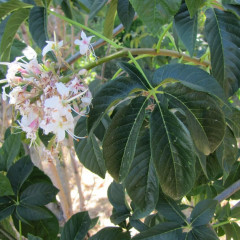
California Buckeye
Aesculus californica. Deciduous tree/shrub with many low branches, rounded crown. Trees leaf out early spring and can drop leaves in hot summer. Dark green, palmate compound leaves with 5-7 leaflets. Candle-shaped clusters of flowers. Leathery pear-shaped fruits open to release glossy brown seeds. All plant parts toxic, but hummingbirds sip nectar; squirrels, chipmunks can consume seeds.

Red Willow
Salix laevigata. Common riparian deciduous shrub/tree in or near creek. Can grow up to 50′ tall and wide within 10 years. Called red willow because newly emerging leaves are red and twigs are yellow to reddish. Leaves 3-4″ long, lanceolate, shiny green above, dull whitish green below. Yellow flowers in drooping catkins produce tufts of cottony, wind-blown seeds. Cuttings used in habitat restoration.

Toyon
Heteromeles arbutifolia. Multi-stemmed evergreen shrub/small tree 6-8′ high, 4-5′ wide. Leaves sharply toothed, 4″ long, 1.5″ wide. Blooms in spring with dense clusters of small, white flowers petals, Butterfly-pollinated, mild Hawthorn scent. Copious red berries in fall-winter contain toxic, bitter-tasting cyanide compounds, but Native Americans ate them after mashing and cooking. Attractive to many fruit eating birds.
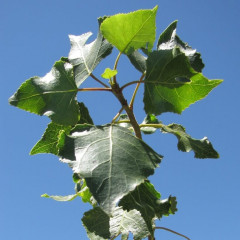
Fremont Cottonwood
Populus fremontii. Riparian, 30-100’, 1-4′ trunk diameter. Leaves heart-shaped, white veins, coarse teeth on margins, hang on stems that are laterally compressed near blade so leaves flutter in wind. Young bark smooth, becoming deeply furrowed with whitish cracked bark. Flowers bloom March-April in drooping 2-6” catkins. Wind dispersed fruit attached to silky, cottony hair. Used in stream bank restoration, traditional medicine.

Black Walnut
Juglans hindsii. Deciduous, planted by Native Americans near their homes. Leaves 1′ long with 13-21 leaflets, dentate margins, unpleasant fragrance. Vein angles bear tufts of hair. Nut has smooth, brown, thick shell containing small edible nutmeat. Hybridizes, only 3 natural, genetically pure groves remain of true N. Ca. species. Attractive to wildlife, resistant to oak root fungus, rootstock for English Walnut.
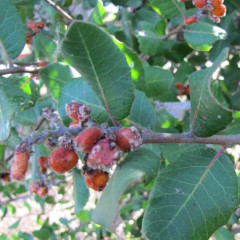
Lemonade Berry
Rhus integrifolia. Shrub/small tree found on dry slopes in coastal chaparral communities. 30′ tall inland, 3′ tall and sprawling near ocean. Leaves simple, evergreen, leathery, 2-3″ long, 1-2″ wide, toothed and waxy above, paler below. Blooms Feb-May, blossoms sticky and clustered. Fruit dark red, sticky, tart . Uses: wildlife food and shelter, drought tolerant landscaping, stream bank stabilization. Sap may be allergenic.
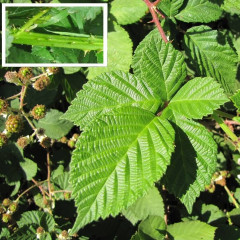
Himalayan Blackberry
Rubus armeniacus. Sprawling rounded evergreen shrub, to 10′ tall. Spreads by roots and runners into large impenetrable patches. Stems up to 0.7″ thick, 5-angled, with many sharp, stout spines. Pinnately compound leaves, 3 to 5 leaflets, dark green upper surface and whitish underside covered in dense short hairs. Introduced in 1885 from India by Luther Burbank, spread by birds, displaces native species.
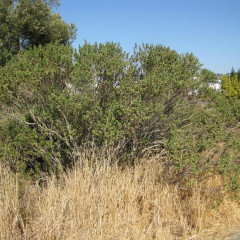
Coyote Brush
Baccharis pilularis. Common upland evergreen 6-10′ tall round shrubs. Dwarf variety (2-4′ tall) planted along Adobe Creek. Leaves small, round to oval, hairless (glabrous), a little stick. Male flowers and female flowers on separate plants (dioecious) cover these plants in late autumn. Important food source and habitat for many species.
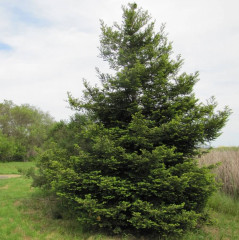
Redwood
Sequoia sempervirens. The species name sempervirens means “always living.” They have red-brown deeply furrowed bark and the red wood so prized for building. Tall and narrow, they can grow fast when young, sometimes 3-5’ per year. After thousands of years growth a few have been recorded as the world’s tallest trees. Leaves 5/8–1″ long. flat. Small cones, 1” long, with dozens of tiny seeds. New trees can sprout from base of parent’s trunk.

Coffeeberry
Frangula californica. Rounded compact evergreen shrub 2-6′ tall. Branches bright gray or brown; twigs smooth to finely hairy. Simple leathery leaves 2-4″ long, elliptic to ovate, generally alternate, maturing to dark green. White star-shaped flowers attractive to birds and butterflies. Fruit ripens from green to orange/red to black in August-October. When red resembles the berry of the coffee plant. Food for diverse species.
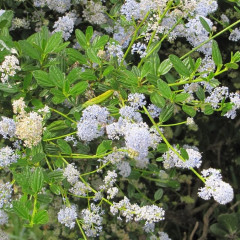
California Lilac
Ceanothus, spp. Large, diverse genus. Shrubs 1-6′ tall. Small oval leaves, glossy upper surface, with most species having 3 parallel veins and serrated edges. Tiny flowers in dense clusters bloom Mar-May look like tiny lilacs. Seed bearing capsules explode with audible ”pop” on hot days, scattering seeds. Many insects attracted to flowers. Birds and small mammals attracted to seeds.
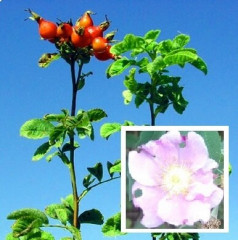
Wild Rose
Rosa californica. Native roses sometimes form thickets or 3-8’ high shrubs. Grey-brown stems, thorns like prickly Velcro. Compound leaves, 2-3 paired leaflets, green above, paler below. Clusters of 1-2” pink flowers at end of stem, bloom May-Nov. Fragrant and edible fruits called hips, provide more vitamin C, calcium, phosphorus and iron than oranges. Become sweet after frost. Used for tea.
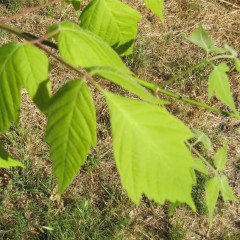
Boxelder
Acer negundo. Riparian, deciduous, fast-growing tree to 60′ tall. Short trunk, wildly spreading branches, broad rounded crown like maples. Leaves pinnately compound with clusters of 3-5 leaflets, opposite, thin, shallowly lobed, light green. Male and female flowers on separate trees. Flowers in long, drooping clusters. Maple-like seeds attract some small birds. Follows cottonwood and willow species in colonizing stream banks.
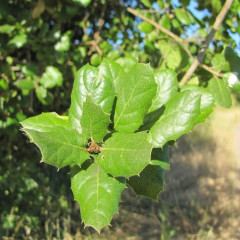
Coast Live Oak
Quercus agrifolia. Broad dense rounded crown, trunk erect or with widely spreading branches, which are often massive, gnarled. Leaves leathery, deep green, oblong to oval, 1-2.5″ with entire to toothed margins, upper surface strongly convex, paler beneath, with hairy-tufted vein axils. Wind pollinated. Single-seeded nuts 0.5-1.4″ called acorns, slender, conical. Flowers Feb-April, fruits mature Aug.- Oct. Important food source and habitat for many bird species.
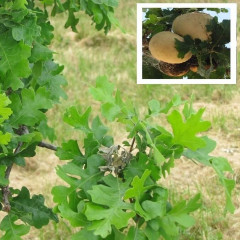
Valley Oak
Quercus lobata. Deciduous dense groves of valley oaks used to grow in groves along streams with other trees and were called “gallery forest.” Farther away from streams they spread out into savannas with luxiorous grass below. Bark checkered or fissured, becoming deeper as the trees age;. Leaves 2- 4.5″ long, half as wide, bluntly lobed. Acorns about 2” valued by Native Americans and by many wildlife species.
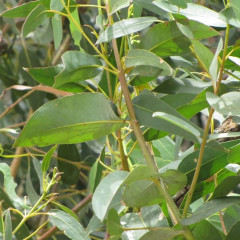
Blue Gum
Eucalyptus globulus. Large Australian native introduced in 1800s for lumber, windrows. Elongate, waxy bluish-green leaves can be straight or slightly sickle-shaped, alternate and dangle from short stems. Used in medical products, foods, perfumes, toothpastes, industrial solvents. Entire tree flammable, explosive. Toxic to local wildlife, leading to low species diversity. Tree line on Ellis Creek used by nesting herons and egrets.

California Blackberry
Rubus ursinus. Deciduous to evergreen mounding or prostrate shrub. Stems round, root at tips, prickles weak, slender, straight. Leaves simple or compound usually in groups of 3, sometimes 5, underside vein bears thin, red spines at regular intervals. Sparse white male and female flowers on separate plants, so berries not abundant. Sweet, edible fruits purple, red, or black, food for diverse wildlife.




